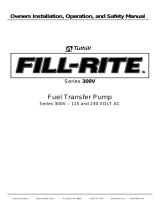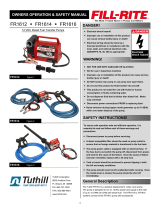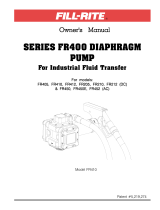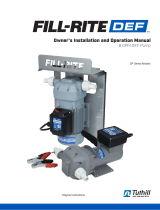Page is loading ...

Original Instructions

Thank You!
Thank you for your purchase of the RD series portable pump! Your Fill-Rite ® product comes with over 80 years of pump
manufacturing experience behind it, providing you the value that comes with superior performance, user friendly design,
outstanding durability, and solid, simple engineering. Experience that gives you peace of mind.
Tuthill. Pump Your Heart Into It!
About This Manual
From initial concept and design through its final production, your Fill-Rite
®
pump is built to give you years of trouble-free
use. To ensure it provides that service, and to avoid injury or death, it is critical that you read this entire manual prior to
attempting to install or operate your new pump. Become familiar with the terms and diagrams, and pay close attention
to the highlighted areas with the following labels:
DANGER! Emphasizes an area in which personal injury or even death will result from failure to follow
instructions properly. Mechanical damage may also occur.
WARNING! Emphasizes an area in which personal injury or even death may result from failure to follow
instructions properly. Mechanical damage may also occur.
IMPORTANT!
These boxes contain information that illustrates a point that may save time, or be key to
proper operation, or claries a step.
At Tuthill, your satisfaction with our products is paramount to us. If you have questions or need assistance with your
product, please contact us at 1-800-634-2695 (M-F 8 AM–5 PM ET).
CAUTION! Failure to observe a “Caution” may cause damage to the equipment.
2
Table of Contents
Safety Information ................................................................................................................................................................ 3
Installation ............................................................................................................................................................................. 3
Bung Mount Conguration....................................................................................................................................................... 4
Mounting Foot and Nozzle Boot Installation................................................................................................................................ 4
Suction Hose Conguration.................................................................................................................................................... 5
Fueling Safety..........................................................................................................................................................................6
Flange Conguration ............................................................................................................................................................ 5
DC Power Connection ........................................................................................................................................................... 6
Power Switch ........................................................................................................................................................................ 7
Operational Safety ................................................................................................................................................................. 7
Troubleshooting ......................................................................................................................................................................8
Cleaning the Inlet Screen........................................................................................................................................................9
Accessories ..........................................................................................................................................................................9
Technical Information ...........................................................................................................................................................10
Motor Tag Information ...........................................................................................................................................................10
Kits and Parts .......................................................................................................................................................................11
Safety Testing Certications .................................................................................................................................................11

Safety Information
DANGER! Electrical wiring should be performed with extreme caution and in compliance with local,
state, and national electrical code NEC/ANSI/NFPA 70, NFPA 30, and NFPA 30A, as appropriate for the
intended use of the pump. Threaded rigid conduit, sealed ttings, and conductor seal should be used
where applicable. The pump must be properly grounded. If installing in deviation of this manual, a licensed
electrician must perform the installation. Improper installation or use of this product will result in serious
bodily injury, or death!
DANGER! To ensure safe and proper operation of your equipment, it is critical to read and adhere to all of
the following safety warnings and precautions. Failure to follow instructions below, improper installation, or
use of this product, will cause serious bodily injury or death!
• NEVER smoke near the pump, or use the pump near open ames when pumping a ammable liquid!
Fire can result!
• This product shall not be used to transfer uids into any type of aircraft due to spark / static discharge
possibility. Spark / static discharge will cause explosions.
CAUTION! This product is not suited for use with uids intended for human consumption or uids
containing water. Materials of construction are not food grade. The pump is water tolerant, however,
extended use with water will shorten the life of the vanes, and can cause swelling of the rotor. Flush / drain
the pump after pumping water to be certain water does not stand in the pump body to prevent premature
wear. Flush with a petroleum product (gasoline, diesel, light oil, etc) to eradicate residual water.
Installation
The Fill-Rite RD Series pump is designed to be portable for your convenience and safety. It features a unique hinged
vane design that eliminates the need for a bypass valve. Because of its unique nature, the RD series pumps can be
installed / used in several congurations. Read each conguration prior to beginning installation.
IMPORTANT! Do not use check valves or foot valves; valves reduce rate of ow and performance of the
pump.
3
IMPORTANT! A Fill-Rite Filter should be used on the pump outlet to ensure no foreign material is
transferred to the fuel tank. Foreign material can damage the equipment being fueled.
WARNING! Threaded pipe joints and connections should be sealed with the appropriate sealant or sealant
tape to minimize the possibility of leaks. Leaking fuel may cause the potential for re and explosion.
CAUTION! The pump motor is equipped with thermal overload protection; if overheated, the motor will
shut off to prevent damage to the windings. If this happens, you must turn off the pump power to reset this
safety feature, and turn the pump back on when it has cooled to continue use. The pump will not restart
until properly cooled.
DANGER! To minimize static electricity build up and possible explosion, use only static wire conductive
hose when pumping ammable uids, and keep the ll nozzle in contact with the container being lled
during the lling process. Spark / static discharge will cause explosions.
WARNING! The RD Series pump is designed primarily for portable applications, using skid tanks, drums,
barrels, and other portable fuel containers to supply fuel. It is paramount to anchor the supply tank or drum
to which the pump is connected to ensure no movement occurs in transit or while fueling. Failure to secure
the tank or drum can cause unexpected and uncontrolled movement, resulting in damage, injury, death, and
potential re or explosion.

1. Change outlet conguration (A) for horizontal discharge
(optional). See Page 6 for instructions.
2. Screw nipple (B) into pump inlet and tighten liquid tight.
3. Screw other end of nipple into bung adapter (C) and tighten
liquid tight.
4. Screw threaded end (D) of the adjustable suction tube into the
bottom of the bung adapter.
5. Extend suction pipe into tank or barrel opening to within 3" of
bottom of tank or barrel. Do not rest suction pipe on bottom.
6. Thread bung adapter into bung and tighten.
7. Install discharge hose with a nozzle or valve at the end that
can be shut off tightly to prevent siphoning when the pump is
not in use.
8. Attach nozzle boot (E) to pump foot (optional).
The RD series pump mounts to the bung by way of the bung
adapter suction tube. The suction tube threads into the bung
adapter, and must be adjusted to a length that positions it within
3” from the bottom of the tank. The tank or drum must be vented.
Be certain power is disconnected before proceeding.
Bung Mount Conguration
B
C
D
A
Mounting Foot and Nozzle Boot
Installation
The mounting foot is bolted to the bottom of the pump using the
two supplied socket head cap screws. Mount the foot with the
longest side facing the front of the pump as illustrated. Torque to
50 in/lbs. with 4 mm hex key.
In bung mount applications a nozzle boot can be attached to the pump
mounting foot for nozzle storage.
• Insert the two - 5 mm socket head cap screws through the nozzle boot.
• Thread the clinch nuts partially onto the 4mm socket head cap screws.
• Insert the nut / screw assembly through slotted openings in the pump
foot.
• Slide the assembly into the narrow end of the slots.
• Use a 4mm hex head key to tighten the nozzle boot into place.
E
Pump Foot
Nozzle
Boot
4
WARNING! Threaded pipe joints and connections should be sealed with the appropriate sealant or sealant
tape to minimize the possibility of leaks. Leaks create the potential for re or explosion.

1. Select chemically compatible inlet and outlet
hoses that contain a static discharge wire, are
for use with ammable liquids, and are rated to
at least 50 psi.
2. Recongure inlet and outlet anges if
necessary (optional). Instructions below.
3. Use a conductive nozzle or valve at the end of
the discharge hose that can be shut off tightly
to prevent accidental siphoning when the pump
is not in use.
4. NOTE: If pumping from a metal container, the
metal end of suction hose MUST be in contact
with the metal container for electrical continuity.
Suction Hose Conguration
WARNING! Threaded pipe joints and connections should be sealed with the appropriate sealant or sealant
tape to minimize the possibility of leaks. Leaks create the potential for re or explosion.
5
NOTE: Hose lengths are longer than shown.
DANGER! Fumes accumulated while fueling create an Explosive Atmosphere. It is CRITICAL that all
possible sources of ignition be removed to a safe distance or extinguished. Sources of ignition would
include (but not be limited to) open ames, cigarettes, static discharge, or electrical connections that can
create a spark. Explosion, re, and severe injury or death will occur if the explosive vapors are ignited.
Fumes accumulated while fueling create an Explosive
Atmosphere around the tank that is being lled. To
avoid possible explosion of accumulated vapors, it is
critical to keep possible sources of spark / ignition at
safe distances from the
fuel vapors.
The accompanying diagram shows minimum safe
distances for safe fueling. 10’ is the minimum safe
distance between:
• Power source and fuel supply.
• Power source and tank being lled.
• Power source and pump.
Fueling Safety

Inspect power cable before each use! Damage to the
outer jacket of the cable that exposes wiring requires
replacement of the power cable.
Install power cable by aligning at on plug with front of
pump. Insert the plug into the pump housing as shown.
Lock into place using the threaded collar (A). HAND
TIGHTEN ONLY! The power cable terminates in green,
black, and red clamps. All three clamps must be used.
1. The green (ground) clamp should be connected rst.
Connect the green clamp to the vehicle chassis or
earth ground. DO NOT connect the green clamp to the
negative power source post.
2. Next, connect the black (negative) clamp to the
negative post of the DC power source.
3. Connect the red (positive) clamp to the positive post
last.
Clamps should be disconnected in reverse order.
DC Power Connection
DANGER! Be certain the power switch is “OFF” prior to connecting the battery clamps / power cables to the
power source or installing the cable into the pump to prevent unexpected starting of the motor. Unexpected
motor start can cause unintended discharge of fuel, creating an explosion and re hazard.
6
Earth /
Chassis
Ground
Green
Red
Black
A
Flat
1
2
3
Flange Conguration
The inlet and outlet anges of your RD series pump can be congured vertically, horizontally, or a combination of both.
To change the position of a ange:
1. Remove the two socket head cap bolts holding the ange in position.
2. Remove the ange; examine the sealing surfaces to be certain they are clean and will seal properly.
3. Position the seal and screen, and place the ange in the desired position.
4. Use the two socket head cap bolts to reattach the ange rmly to the pump housing. Torque to 50 inch lbs. with a 4
mm hex key.
WARNING! Be certain seals and screen are properly positioned and clean any time the anges are
recongured. Improperly installed or dirty seals or screens could cause leaks and the potential for re or
explosion
Inlet Outlet
CAUTION! Always be certain the power switch is accessible after reconguring the inlet and outlet ports.

Power Switch
The RD series pump features a sliding ON / OFF power switch. The switch is located on top of the pump at the back of
the pump housing. To operate the pump, push the switch to the desired position. Push “ON” to operate the pump, and
push “OFF” to turn the pump off.
NOTE: The side where the switch button is depressed is the function the switch is performing.
IMPORTANT! The RD series pump uses thermal overload protection to prevent overheating. If the pump
shuts off due to thermal overload, turn the power switch “OFF”. Once the pump cools the switch can be set
to “ON” again to reset the thermal protection.
DANGER! Be certain the power switch is “OFF” prior to connecting the battery clamps / power cables to the
power source or installing the cable into the pump to prevent unexpected starting of the motor. Unexpected
motor start can cause unintended discharge of fuel, creating an explosion and / or re hazard.
Pump off Pump on
WARNING! The RD series pump body can become hot with extended use. Always use the handle to lift and
carry the pump when moving it. Use caution when gripping the handle as exposed skin may be burned if it
contacts a hot pump.
WARNING! Use caution when operating or carrying the pump. The hoses and electrical power cable can
be a trip hazard; caution should be exercised any time the pump is moved with the hoses and power cable
connected to avoid tripping or entanglement.
Operational Safety
WARNING! NEVER disconnect the power cable from the pump while pump is switched on or connected to a
power source. ALWAYS switch the pump off and disconnect all the clamps from the power source PRIOR
to disconnecting the power cable from the pump. Electrical shorts, sparks, or unexpected start up can occur.
DANGER! DO NOT use pump in enclosed areas when pumping hazardous or explosive uids. Pumping
area should be well ventilated. Concentrated vapors in an enclosed area are noxious and highly explosive!
WARNING! Pump assembly can become hot with extended use. Use caution when handling the pump after
use; always use the handle to move or hold the pump. Pump has 30 minute on / 30 minute off duty cycle.
CAUTION! DO NOT operate the pump if any part of the explosion proof motor construction is missing or
compromised. Disassembly of the motor will compromise the explosion proof design and void any warranty.
CAUTION! DO NOT operate the pump dry for more than 30 seconds. DO NOT operate the pump in bypass
more than 5 minutes. Damage to the pump will occur.
7

Troubleshooting
This Troubleshooting guide provides basic diagnostic assistance. If you have further questions, contact us at 1-800-634-
2695 (M-F 8 AM–5 PM ET), or on the web at “www.llrite.com”.
DANGER! DO NOT open or attempt to repair the motor on your Tuthill pump. Return it to the place
of purchase for service. Opening the motor case will compromise the integrity of the Explosion Proof
construction and void any existing warranty, approvals, and certications (i.e.: ATEX, UL listing, CE, etc.).
DANGER! Disconnect all power prior to performing any service or maintenance. Failure to disconnect the
power may cause electrical shock, or unexpected starting of the motor, resulting in injury or death.
Symptom Cause Cure
Pump won’t prime. Suction line problem. Check suction line for leaks or restrictions; it may be
too small in diameter, too long, not air tight, or too low
vertically.
Vanes sticking. Check vanes for nicks, damage, obstructions, or
excess wear. Replace as necessary.
Excessive rotor, vane, rotor cover,
or housing wear.
Inspect rotor, vanes, rotor cover, and housing for
excess wear; replace as necessary.
Inlet / Outlet blocked. Check pump, hose, nozzle, and lter / strainer for
blockage.
Vapor lock. Reduce vertical or horizontal distance from pump to
liquid.
Power connections reversed. Correct power connections.
Motor stalls / fuse blows. Short in wiring. Inspect electrical cable for shorts and replace as
necessary.
Excess rotor or vane wear. Check vanes for nicks, damage, obstructions, or
excess wear. Replace as necessary.
Pump rotor lock-up. Clean and inspect rotor and vanes.
Debris in pump cavity. Clean debris from pump cavity.
Components swell from pumping
water.
Let pump dry completely.
Low capacity. Excessive dirt in screen. Remove and clean screen.
Suction line problem. Check suction line for leaks or restrictions; it may be
too small in diameter, too long, not air tight, or too low
vertically.
Excessive rotor, vane, rotor cover,
or housing wear.
Inspect rotor, vanes, rotor cover, and housing for
excess wear; replace as necessary.
Hose or nozzle damage. Replace hose or nozzle.
Low uid level. Rell tank.
Pump runs slowly. Incorrect voltage. Check incoming line voltage while pump is running.
Vanes sticking. Check vanes for nicks, damage, obstructions, or
excess wear. Replace as necessary.
Wiring problem. Check for loose connections.
Motor problem. Return to place of purchase.
Bold text indicates repairs that are not serviceable by the owner; pump must be returned to the point of purchase for repairs.
8

Troubleshooting (cont’d)
Bold text indicates repairs that are not serviceable by the owner; pump must be returned to the point of purchase for repairs.
Symptom Cause Cure
Pump hums but will not
operate.
Motor failure. Return to place of purchase.
Motor overheats. Pumping high viscosity uids. These uids can only be pumped for short periods of
time (less than the 30 minute duty cycle).
Clogged screen. Remove and clean screen.
Restricted suction pipe. Remove and clean pipe.
Motor failure. Return to place of purchase.
Pump rotor lock-up. Clean and inspect rotor and vanes.
Motor inoperative. No power. Check incoming power.
Switch failure. Return to place of purchase.
Incorrect or loose wiring. Check wiring / connections.
Motor inoperative. No power. Check incoming power.
Switch failure. Return to place of purchase.
Motor failure. Return to place of purchase.
Motor overheated. Switch off and allow to cool.
Incorrect or loose wiring. Check wiring / connections.
Fuse has blown. Replace 30A fuse.
Cleaning the Inlet Screen
Regular inspection and cleaning of the inlet screen on your RD
series pump helps maintain performance and ow. Access the
screen by removing the inlet ange as described on page 5.
Clean, rinse, and dry the screen throughly before re-installing.
Inspect the screen, seals, and ange area for debris and
damage. If screen or O-rings are damaged, replace with kit
KIT812SL.
Screen
Accessory Description
1200KTF7018 10 Micron Particulate Filter Kit (Bung mount installations only)
F1810PM0 10 Micron Replacement Spin-on Filter (Particulate) (Bung mount installations only)
1210KTF7019 Hydrosorb Filter Kit (Bung mount installations only)
F1810HM0 Hydrosorb Replacement Spin-on lter. (Bung mount installations only)
FRHMN075S 3/4” Manual Nozzle
Accessories
9
Fluid leakage. Bad o-ring gasket. Check all o-rings.
Bad shaft seal. Return to place of purchase.
Incompatible uid. Refer to wetted parts list (page 10).
Loose fasteners. Tighten fasteners.
Inadequate plumbing seals. Reseal plumbing connections.

Technical Information
Motor RD8 RD12
Power - DC 12, 24, 12/24 12 VDC 12 VDC
HP (horsepower) rating 1/6 HP 1/6 HP
Power cable length 10’ 10’
Power cable gauge 14 AWG 14 AWG
Power cable DC battery connectors Yes Yes
Amps (FLA) 14 A 14 A
RPM 3600 3600
Duty cycle 30 min. ON / 30 min. OFF 30 min. ON / 30 min. OFF
Thermal Protection Yes Yes
Circuit protection fuse Yes (30 Amp Fuse) Yes (30 Amp Fuse)
Certication UL/cUL Motor/CE/ATEX/IECEx Pump UL/cUL Motor/CE/ATEX/IECEx Pump
Pump
Type- rotary, diaphragm, gear, vane Rotary Hinged Vane Rotary Hinged Vane
Flow Rate (with supplied hose / nozzle) Up to 8 GPM / 30 LPM Up to 12 GPM / 45 LPM
Flow Rate open ow - no hose or nozzle Up to 10 GPM / 38 LPM Up to 13 GPM / 50 LPM
Max discharge pressure 16 PSI 16 PSI
Dry vac (in Hg) 5 in vacuum 5 in vacuum
Head- Max (ft) 37’ 37’
Anti-siphon valve None None
Inlet - Size / Thread 3/4” NPT / BSPP 3/4” NPT / BSPP
Outlet – Size / Thread 3/4” NPT / BSPP 3/4” NPT / BSPP
Mount 2” Bung (NPT) / BSPT 2” Bung (NPT) / BSPT
Materials of construction -pump housing Aluminum Aluminum
Materials of construction- wetted material BUNA-N + HNBR BUNA-N + HNBR
Rotor materials of construction Nylon Nylon
Rotor vane material of construction Acetal Acetal
Compatible uids Diesel, Gasoline, BioDiesel up to
B20, E15, Kerosene, Mineral Spirits,
Methanol (up to 15%)
Diesel, Gasoline, BioDiesel up to
B20, E15, Kerosene, Mineral Spirits,
Methanol (up to 15%)
Strainer Mesh Size 20 x 20 20 x 20
Warranty (yr) 2 Year 2 Year
Maximum Sound Level 65 dB (A) 65 dB (A)
10
Motor Tag Information
The carrying handle on your RD series pump contains
important technical, performance, and certication
information. For your specic model certication,
reference the regulatory marks on your pumps
handle. Be certain this handle remains afxed to the
pump at all times.

11
Kits and Parts
Kit Number Description Parts
KIT812PC Power Cable Kit Quick Connect Power Cable Assembly 9 and Instructions*
KIT812PCE Power Cable Kit (Europe) Quick Connect Power Cable Assembly 9 and Instructions*
KIT812RG
KIT1212RG**
Rebuild Kit Rotor & Vanes 4 , Rotor Cover 1 , Inlet Screen 8 , Flange O-rings 7 ,
Rotor Cover O-Ring 3 , Flange Fasteners 6 , Rotor Cover Fasteners 2 ,
and Instructions*
KIT812FL Single Flange Kit (NPT) Flange 5 , Inlet Screen 8 , Flange O-Ring 7 , Flange Fasteners 6 , and
Instructions*
KIT812FLB Single Flange Kit (BSPP) Flange 5 , Inlet Screen 8 , Flange O-Ring 7 , Flange Fasteners 6 , and
Instructions*
KIT812SL Seal Kit Inlet Screen 8 , Flange O-rings 7 , Rotor Cover O-Ring 3 , Flange
Fasteners 6 , Rotor Cover Fasteners 2 , and Instructions*
KIT812NH Hose Kit 3/4” x 6’ Suction Hose
◊
, 5/8” x 8’ Discharge Hose
◊
, PTFE Tape*, and
Instructions*
KIT1212NH** Hose Kit 3/4” x 6’ Suction Hose
◊
, 3/4” x 8’ Discharge Hose
◊
, PTFE Tape*, and
Instructions*
KIT812NP Bung Mount Kit Suction Tube
◊
, Bung Adapter
◊
, Nipple
◊
, Nozzle Boot
◊
, Nozzle Boot
Fasteners
◊
, PTFE Tape*, Instructions*
1
2
3
4
5
6
7
8
9
5
*Item not shown.
**Kit for RD12 Application
◊
Item shown on page 4 and 5.
Safety Testing Certications
This Fill-Rite line of pumps have been safety tested for compliance to strict regulatory standards. Check the information
on the handle of your pump to determine the certications that are applicable to your particular model.
Certication testing information is located on the back cover of this manual.

12
DC001582-000 Rev.5
Safety Testing Information
The following standards were used to show compliance in North America:
UL 674 – Electric Motors and Generators for Use in Division 1 Hazardous (Classified) Locations, 5th Edition. The
following standards were used to show compliance in the European Union:
Directive 2014/34/EU – Equipment and protective systems intended for use in potentially
explosive atmospheres.
EN 60079-0:2012 Explosive atmospheres – Part 0: Equipment – General requirement.
EN 60079-1:2014 Explosive atmospheres – Part 1: Equipment protection by flameproof enclosures “d”.*
IEC 60079-0 Explosive atmospheres – Part 0: Equipment – General requirements, 6th Edition.
IEC 60079-1 Explosive atmospheres – Part 1: Equipment protection by flameproof enclosures “d”, 7th Edition. Directive
2006/42/EC – Directive on machinery.
EN 809:1998 +A:2009 – Pumps and pump units for liquids – Common safety requirements.
EN ISO 12100:2010 – Safety of Machinery – Basic concepts, general principles for design.
Directive 2004/108/EC – Electromagnetic compatibility.
Directive 2011/65/EU – Restrictions of the use of certain hazardous substances in electrical and electronic
equipment.
*The minimum and maximum values of the flameproof joints differ from what is specified in Table 2 of
EN60079-1:2014. Manufacturer is to be contacted for information on the dimensions of the flameproof joints.
*The fasteners used to secure the steel can to the aluminum housing have a yield strength of 1100MPa.
www.llrite.com
USA
/









